Written by Tom Wright - http://life.tomwright.me.uk
Nadia proposed a race abroad to celebrate my 40th on the proviso there was sun and it fell in March. The grandparents/babysitters were in town. Only two races fitted the bill: Antiparos 100km - a lap race around a Greek island; or North Face Transgrancanaria. I didn’t have a qualifying time for the former and while the latter was full, being the third leg of the Ultra Trail World Tour, it’s shorter sibling, the Advanced course, had spaces. At 85km and 4800m ascent this was as big an undertaking as I had faced and once registered I hastily got to work running up and down hills to get elevation experience in my legs after a lethargic start to winter.
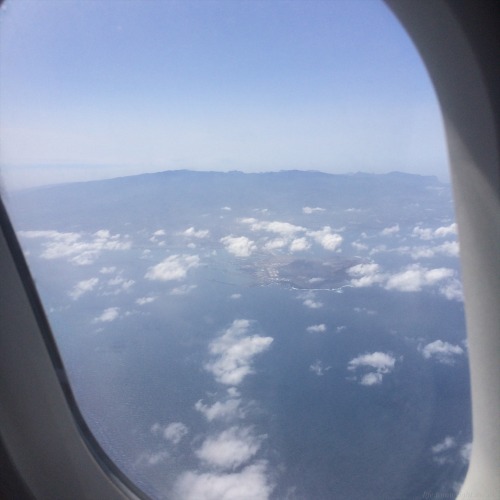
First views of Gran Canaria’s volcanic mountains on the flight in. Roque Nublo is just visible in the centre of the image.
We found a package tour for a long weekend, flying from Birmingham, and staying at the H10 on Playa Meloneras just a 10 minutes walk from the Expo centre where the race registration and finish would take place. The grandeur of the event was apparent from the outset as celebrities of the ultrarunning world convened on the small resort. Before we even left Las Palmas airport I had introduced myself to Talk Ultra’s Ian Corless who just happened to be stood next to me at the baggage belt. His voice had rung through my ears on countless long runs as I plugged in to the de facto ultrarunning podcast so it felt surreal putting a face to the voice and I will admit I was a somewhat starstruck as I fumbled my introductions. Not without taking heed of Ian’s warnings of the technicality and difficulty of the course I would face. The press were based in H10 so we got many more opportunities to chat running with Ian as well as spotting Nuria Picas, Brendan Davies and a few other big names from the sport at the Friday morning press conference.
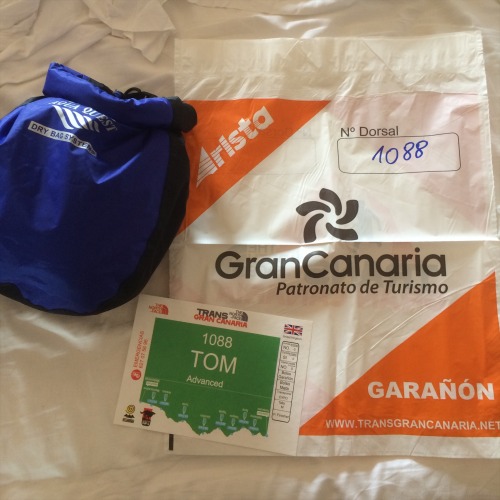
Friday lunchtime I jogged over to the Expo centre to hand in my drop bag while Nadia made far more sensible use of the sun’s rays to top up her vitamin D. A chance to acclimatise to the heat of the day perhaps. Ten minutes in and my back was dripping with sweat. The air temperature was around 24 degrees and there was little breeze. The Expo was buzzing with anticipation. There was no queue and I regretted registering the previous evening when Nadia and I, both exhausted from a 5am journey, had queued amongst a throng of Spaniards for 30 minutes to collect my race number and timing chip. The Advanced race formed part of the Spanish Ultra Cup hence seventy percent of the field was Spanish. The organisers announced that athletes from 71 countries were taking part across the five races that formed the weekends challenges so despite the Spanish dominance it was certainly an international affair.
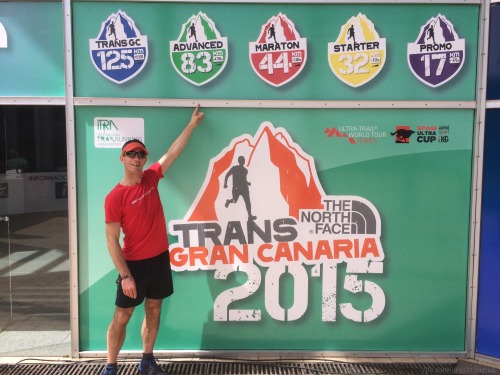
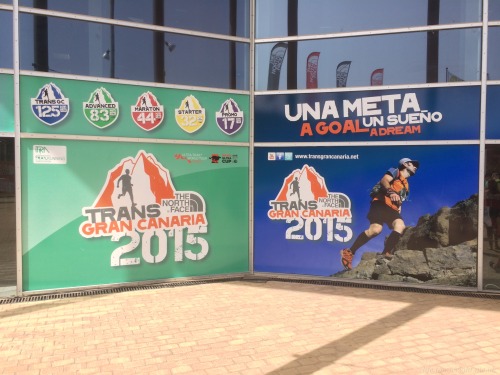
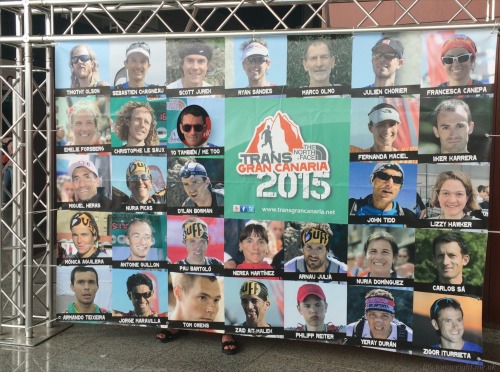
An afternoon sat poolside in the shade ensued. Having come from an English winter, I didn’t want my race curtailed by sun stroke! Dinner was a sedentary affair at the all you can eat buffet for fear of food poisoning and by 10pm, thanks to a cerveza and house red, I was, for once, actually sound asleep. Thanks to several weeks of early morning commute reciting my race day routine I had expectations of a smooth affair. Surprisingly, despite a lack of caffeine, the 3am start went well. Awoke to the ringing chimes of Major Tom; scoffed a Lizi’s granola (just add water); contact lenses applied to squinted eyes; 10 minutes lubricating; 5 minutes applying sun block; another granola; teeth brushed; donned kit; checked pack; jog to Expo for 4:10am coach…
I was drifting in and out of sleep as the coach came to a sudden halt and we were ushered on to the dark streets of Fontanales. I had shared the journey with Martin, an English runner currently residing in Norway, who had chosen this event as his inauguration into ultra running. The chit-chat had been interspersed with brief spells of reflection. The last time I ran Spanish mountains was Montgo’s rugged pathways. I was excited at the prospect of visiting similar terrain and bringing some of the expertise I had developed there to this challenge. The start was still an hour distant and time drew slowly. At first I composed myself in a dark corner of the village nibbling at a Chia Charge bar mentally reciting my strategies. The air was cool and I huddled under both my Montane marathon jacket and Minimus smock, being the only two layers I chose to bring.
For the past few weeks, as usual, I fastidiously studied a map of Gran Canaria and virtual fly overs of the route on Google Earth. I had a broad idea of the main challenges and where opportunities to make up time would arise. Simply stated the course was an uphill marathon followed by a downhill marathon. The contours gave clues to a few hurdles over the second half. The main unknowns would be: the terrain and the sun. The longest I had previously run under a Spanish sun was twenty miles but that was self supported. Most feed stations here were close together. There was, however, a long ten mile section on the back half of the course we would face in the heat of the afternoon. My plan was to eat solid food on the long climbs, try and eat a hot meal at the half way point and turn to shot blocks and gels on the more arid back half. I would keep drinking regularly with a mix of Nuun (calorie free) and High5 (calories). There you have it - a plan of sorts.
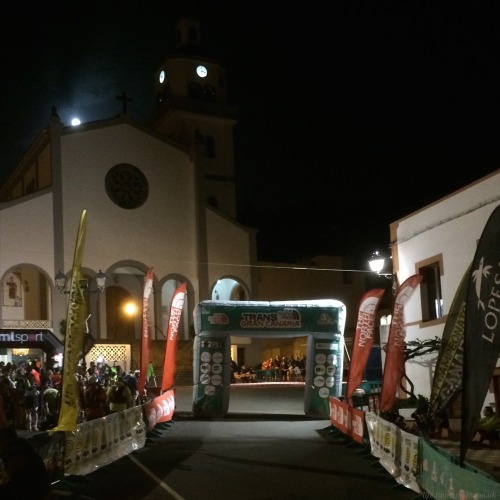
I reconvened with Martin for a quick coffee at an overflowing café. Before converging on the slow-moving queue for the toilet. We made our way down the steep hill to the start and as our reckoning drew closer time accelerated. The sun was just starting to pierce the blackness of night. A relief as I chose to leave my Black Diamond head torch tucked away in the bottom of my Salomon pack. Huddled towards the back of the five hundred strong field the countdown begun.
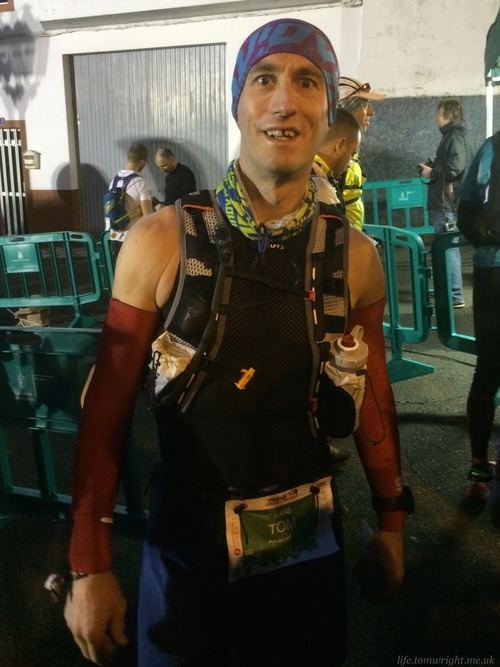
Ready and raring to go
Cinco… cuatro… tres… dos… uno…
Fontanales to Teror (752m ascent)
The hooter sounded and we were off. Well, the elite athletes were off at a sprint back up the steep road. We had several minutes wait before finally shuffling under the starting gate, to the pulsating thump of the DJs music, past the throng of cheering spectators and off into the hills.
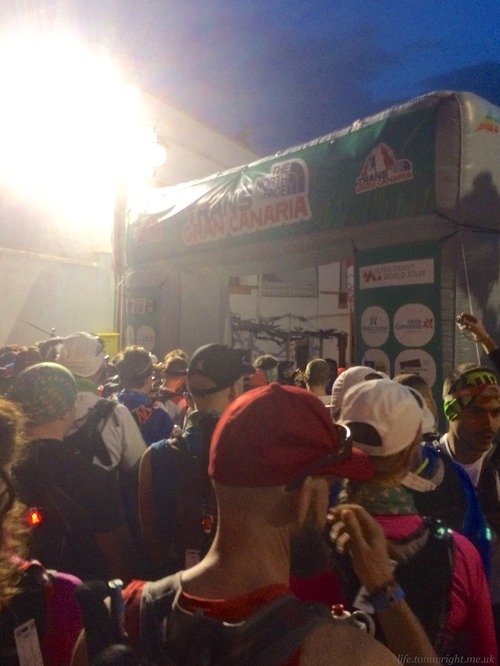
As the road quickly gave way to trail I learned the value in jostling for a position on the start line. We hit a severe bottleneck. It was single file traffic at best on a gradual incline and pace was very slow. Worryingly the pace hardly picked up as we went downhill!

So for the first few miles I struggled my way past runners at every opportunity sometimes squeezing by on the inside with an expressive gracias, other times making use of short sections of road to run fast. It was gratifying to finally stretch out the legs after several weeks of tapering but Dave’s words at the RAT the previous summer still weighed on my mind and I was wary of exerting my quads so early in the race.

The first long descent was a sharp collection of switchbacks underlaid with smooth boulders. I threw caution to the morning breeze on several tight bends opting to leap over boulders simply to gain a position eager that I might free myself from the procession. But to little avail. The trail bought us into a desolate village and the first long climb of the day. Barely a spike on the profile yet on the ground it felt long as we weaved up the lush wooded valley in the shadow of Mount Lentisco.

Looking back at the line of runners I estimated I had moved into the middle half of the field. The exertion of the ascent had me sweating heavily and I was relieved I chose to run in just a mesh vest and arm warmers. I tried to keep focus in the moment but couldn’t prevent my frenetic mind wandering to the much bigger climbs to come beyond Teror. At least the legs and the back showed no sign of tiring at this early stage and once over the summit it was more downhill queues into Vallesco and the first feed station.
A crowd of runners were gathered around the water/coke vats in the village and I saw little need to stop as I switched my handheld to a full bottle from my pack. So I ran straight through the feed station and hit the next small climb.
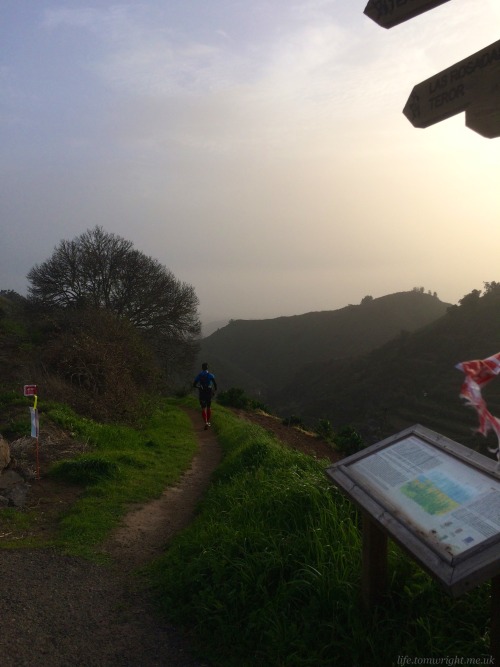
As the long descent to the first checkpoint began I hit more bottlenecks and this time it was far too narrow to overtake. We weaved through some fairly dense and lush vegetation on the easy going trail. I heard a frustrated shout in English from behind as we moved very slowly down hill, limited by the pace set by those in front. Descending is my strength and I too began to feel exasperated as the minutes seemed to slip away. Unfortunately, as trail gave way to tarmac and the road widened, I continued to neglect my quads and ran fast down the steep tarmac slopes into Teror.
Entry to the feed station in the town square was lined with a bizarre collection of giant inflatable cartoon characters. From the Simpsons no less! Yet far more impressive it stood in the shadow of the Basilica de Nuestra Senora del Pino - the cathedral to the patron saint of the island. A marshal stepped forward and scanned my number with a high tech looking, but oversized, laser gadget while a young helper kindly filled up my water bottles. Tables were lined with nuts, crisps, cheeses, fruits and meat cuts. Conscious of my heavy sweating I grabbed a handful of salted nuts and set off on the first big climb of the race.
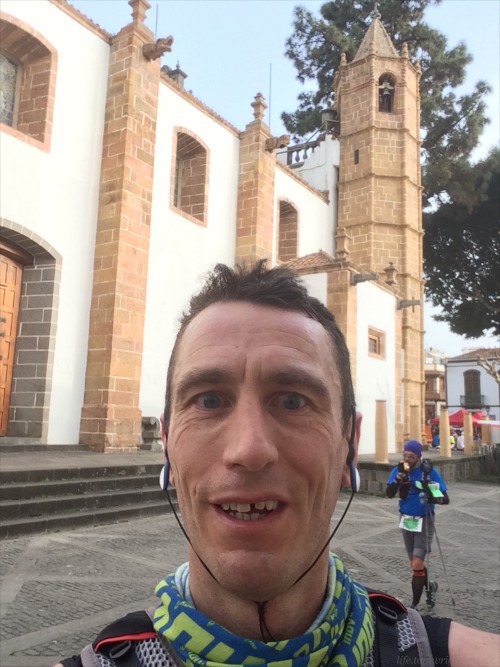
I would like to have explored this pretty little town if only there had been more time!
Teror to Cruz de Tejeda (1275m ascent)
Specificity! I hear it all the time but repeatedly fail to apply it to my training plans. Besides, how can you train for a 1000m ascent in Cornwall? Eighty metre hill repetitions just aren’t the same. I learned this in 2014 running the Black Mountains and Brecon Beacons. That realisation was about to reach a whole new level as I set out from Teror on the first major climb.
Teror seems a fitting name for the town at the base of 4000 feet of climbing that would take us past El Penón at 1640 metres. The tarmac road gave way to steep steps. I was moving pretty well amongst a group of runners and felt comfortable with progress at a steady pace. We briefly joined the GC-42 road and then bore right onto a track lined with eucalyptus. Simon Darmody, fifteenth at last year’s Lakeland 50, came up alongside me. He was that frustrated English man but embarrassingly noted that the runner holding us up had in fact been running the 125 km course. We chatted briefly. I started to feel the lactic acid building in my legs and a slight sensation of cramp in my quads so, as Simon jogged on I bade farewell and resigned to power walking. We passed Cruz de la Hoya Alta and I took a few moments to take in the sweeping view back down the valley before continuing the climb.
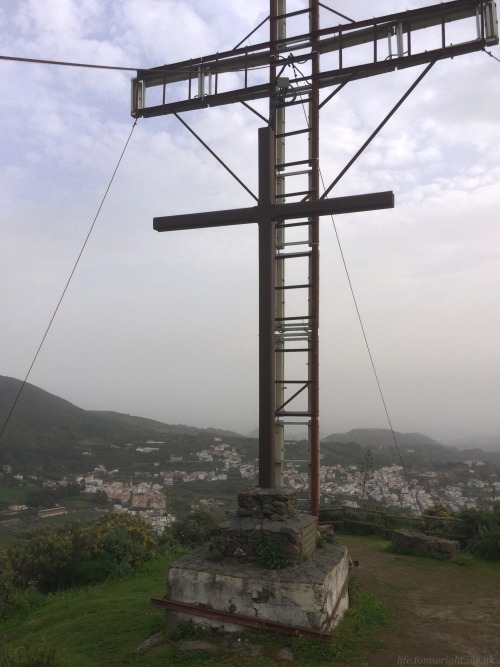
The two crosses, one wooden and one metal standing proud over Teror.
We took a rolling path along the mountain ridge. The climbs short and steep with numerous switchbacks interspersed with brief descents. Two steps up, one step down!
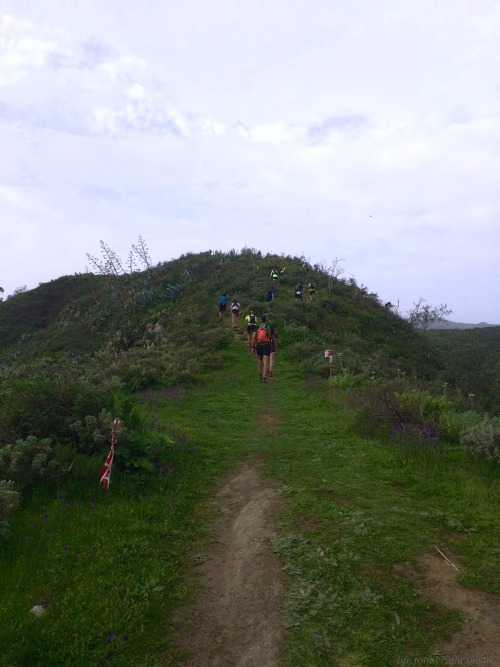
There was little protection from a building Saharan breeze on the crests and this added to the challenge but kindly kept the temperature bearable. The sun was obscured by an omnipresent haze. The calima I later learned - a rare annual event that sweeps dust in from the African desert. Unfortunately it looked like visibility would be poor today and the colours of the mountains a little desaturated. So with my sightseeing plans disrupted by meteorological anomalies I buried my head down low, pushed hard on my thighs and soldiered on.
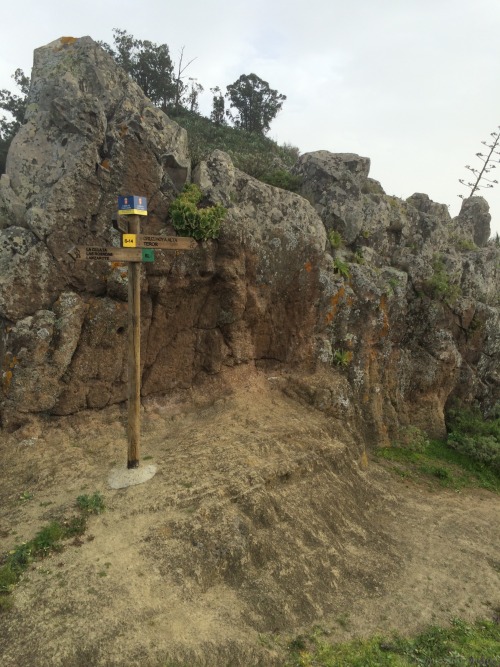
It felt alien having so many runners in close proximity well into the race but gave opportunity to gauge my progress and everyone appeared to be moving slowly. I occasionally glanced at my watch as the average pace rapidly fell from 12 minute miles to 15 minute miles. My heart sank a little. This was well outside my projections for a finish in daylight. There were distance markers on the course every 5 kilometres and it felt a very long time since I had seen one. Contemplating this I came upon the feed station at Talyon. It was bustling. There were a few runners sat in chairs. This was enticing but before the temptation consumed me I hurriedly topped up my electrolyte infused bottles, grabbed another handful of nuts and took flight.
Just down the road the 65km sign finally came into view. It was scant consolation knowing there was still so far to go. With all this climbing my cup was certainly half empty today. Negativity was having a big impact on my confidence and my performance.
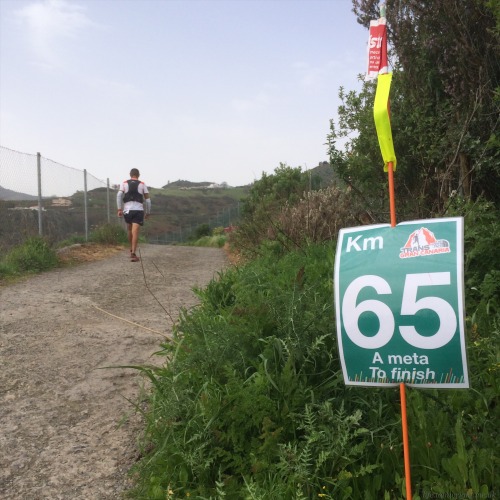
Great only 65km to go!
Then the climbing returned in earnest. A really steep slog weaving through a desolate landscape of felled and scorched trees. My speed through the feed station saw me break away from the group of runners I had been with but now as my inexperienced legs grew weary I was reeled in. If I pushed hard up hill I felt pangs of cramp again. I put this down to the salted nuts and vowed to stay clear of them for the rest of the race. The track briefly joined road where a small crowd of spectators had gathered. The atmosphere was exciting and this gave me a brief lift amidst exclamations of vamos and animo. Then the climbing just got worse under the shade of a pine forest. As the straight path became further switchbacks my pace slowed to a crawl. Twenty runners must have overtaken me on that stretch. Nearly all of them, bar a couple of ladies, using poles.
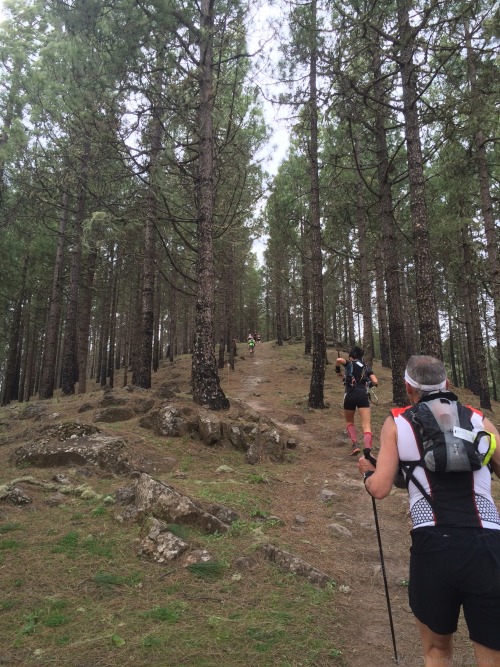
It was a lot steeper than it appears! Or at least after nearly 1000m of climbing it felt a lot steeper.
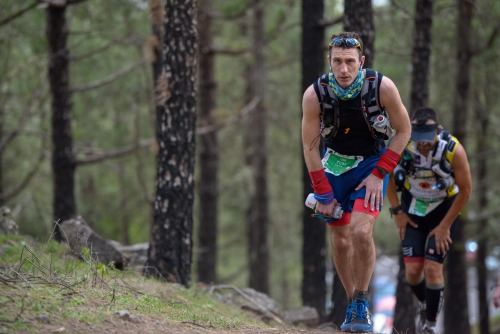
The focus hides the pain I was feeling inside!
Finally, after 10km of almost continuous climbing we hit the summit. It took a few minutes to feel my legs again and I eased into the descent aware of the exertion my quads had already undergone and very aware of the steep drop off the narrow path (were one to trip). Not being a feed station the checkpoint, and another large scanner, came and went.
Cruz de Tejeda to Roque Nublo (917m ascent)
The next two miles were easy going rocky trail as we plummeted into the Tejeda caldera. A chance to pick off runners that had bettered me on the climb. Legs restored I felt comfortable with a little gravitational assistance. The panoramic mountainous terrain reached into the hazy skyline. The Spanish philosopher, Miguel de Unamuno, described the region as ‘a tremendous upheaval of the entrails of the earth’. Rock formations spewed out across the landscape and holding court the monolithic Roque Nublo. An impressive basaltic plug majestically rising 80m above the plateau. The landscape truly was a ‘Petrified Storm’ and I was excited at the prospect of visiting the rock. Although it looked another very long, big climb!
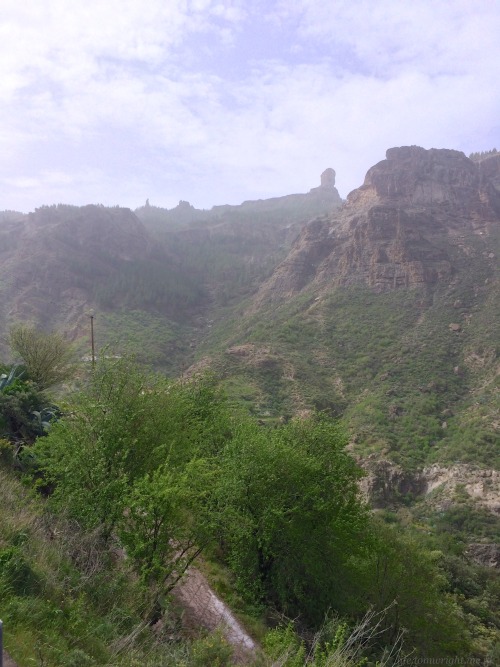
Looking up to Roque Nublo with El Fraile (The Monk) the smaller volcanic neck on the left.
Arriving at Tejeda feed station my thoughts turned to nourishment. I was hot, thirsty and hungry but reluctant to consume more salted nuts. So I turned to large quarters of fresh, home grown, oranges. They hit the spot as I consumed two whole oranges worth, sucking out the juice and discarding the pith and skin. Not sure this would greatly benefit my calorie intake but it tasted succulent and was readily digestible. I had been struggling for some time to eat Clif bars and flapjacks which were all too dry. There was a queue for water and I found myself having to stand firm to hold my place in the bustling pack. The route continued downhill on tarmac as we battled an incessant wind whipping through the valley. One sudden gust took my cap off which fortunately landed in the face of a runner on my tail rather than blowing clean over the edge into the valley below.
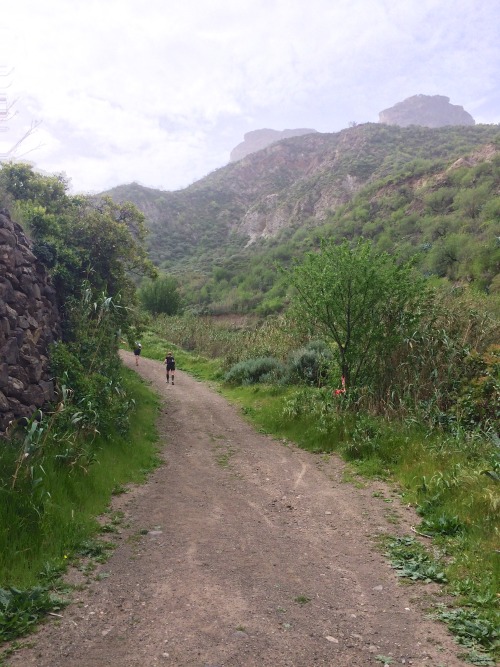
Fortunately the unforgiving tarmac was short lived and we were back on a gravel track which gave way to more steep rubble strewn switchbacks as we took a trail up the valley and around the western side of the Roque Nublo plateau. Sheltered from the wind the temperature quickly rose. I struggled to eat a Chia protein bar - too dry also. Again the same runners were overtaking as my pace became sluggish.
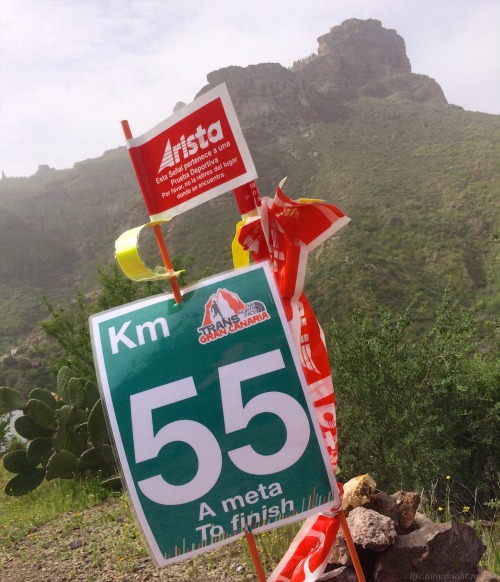
Even an elderly man just out for a walk moved faster than me up the steep ascent! This at least made me chuckle and I texted the fact, along with my progress, to Nadia.
11:39: “an old man is going up hill faster than me now! x”
I allowed photo opportunities as a means to catch my breath and let the legs rest convincing myself that once on the plateau it would be a short run to the hot feed station at Garañón where I could recuperate. Despite the haze the views were inspiring. There was even an occasional eccentricity. High up on the mountainside, a green wooden door cemented into the hillside!
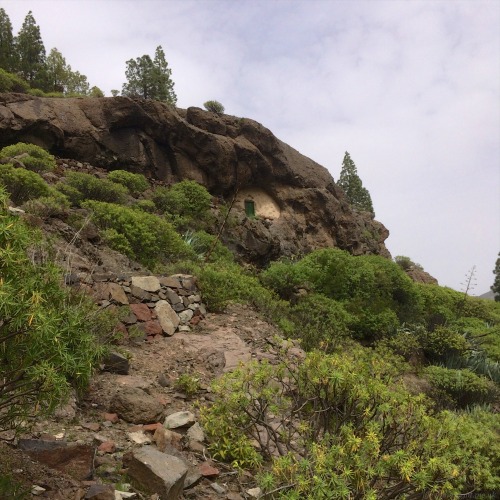
There be hobbits living here
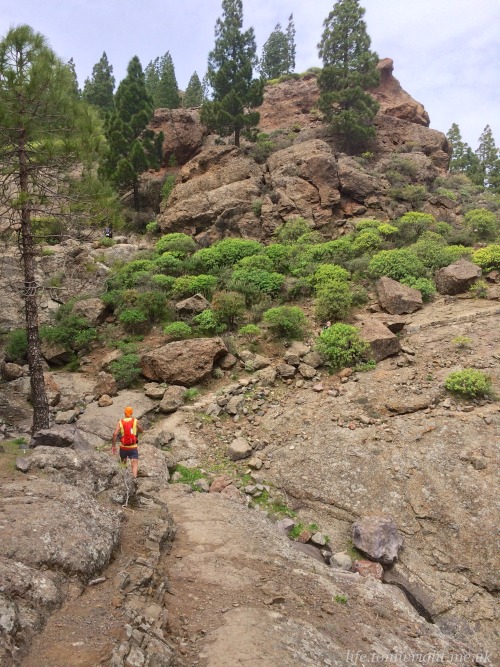
Slow ascent on rubble switchbacks
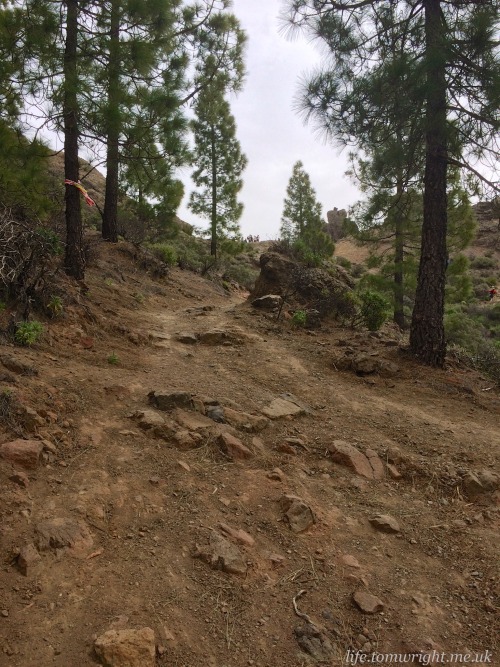
In the shadow of the rock we passed through more pine forest with rock and root strewn trails.
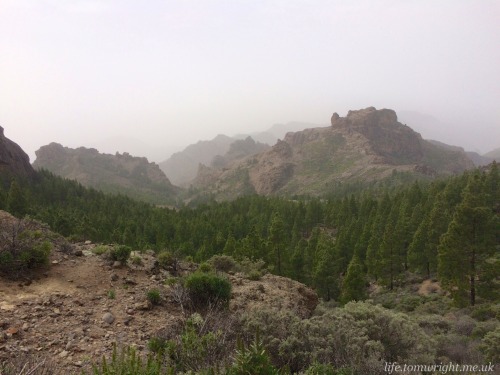
Looking south-west Mount Aserrador rises out of the haze
The last part of the climb was gradual and I found my running legs. The terrain dramatically changed from root laden wooded trails to a bizarre volcanic amalgam of sharp protrusions and rounded boulders on the plateau.
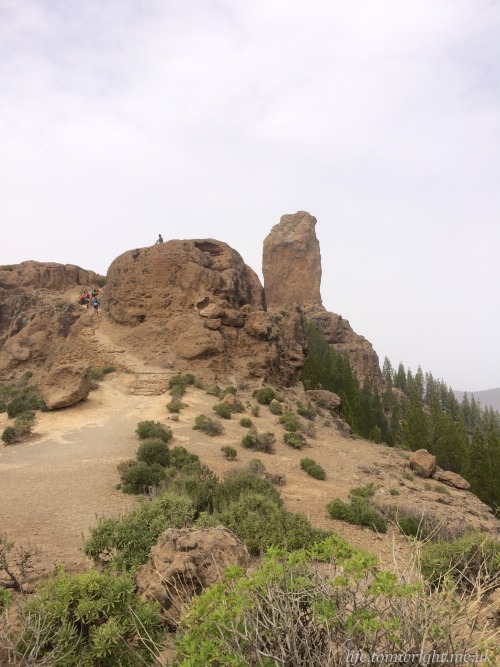
It was a short diversion to the timing control under the rock. Once my number was scanned I asked the marshall to take a photo for me. I had studied Roque Nublo on Google Maps with my daughter, Olive, and here was proof that I had succeeded in my climb.
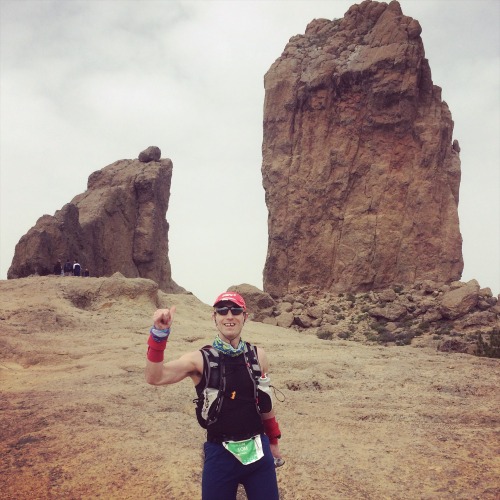
Roque Nublo to Pico Nieves (492m ascent)
The track descended quickly off the plateau followed by some undulating woodland trail before dropping down to the impressive Los Hornos dam. Crossing a reservoir of cool water was a cruel twist when feeling so parched. Around this point I started feeling decidedly queasy. I stopped to drink some electrolyte and moved on slowly.
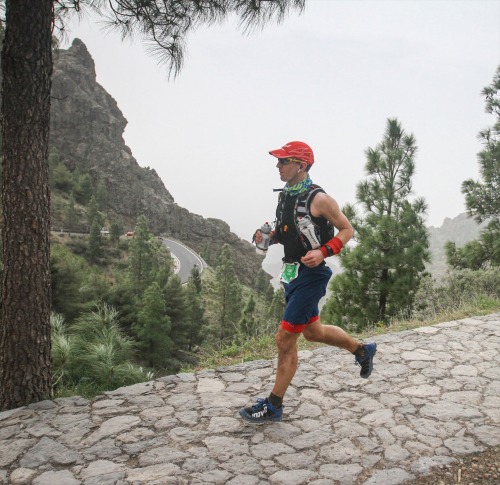
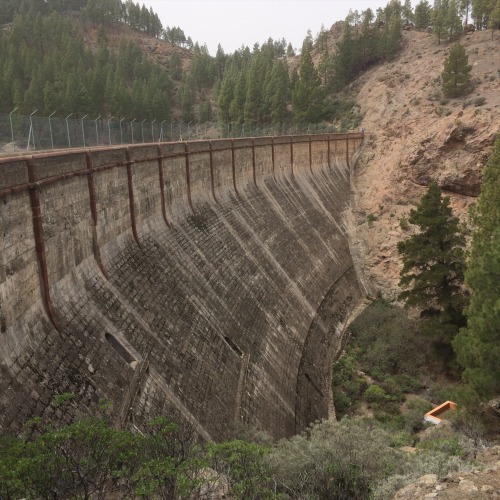
The heat of the midday sun was getting to me, despite being 5000 feet above sea level. I tried to convince myself it would soon be downhill all the way but the foreboding climb to Pico Nieves and another marathon of distance was overwhelming. I had already ascended and descended the equivalent of our highest Welsh mountains twice - this felt like more than my legs could handle. One more short climb and I stumbled into the feed station at Garañón to a large supportive crowd. Several people called out ‘Animo Tom’. At first I was confused how they knew me until I twigged the letters T.O.M. were engraved across my number around my waist. I don’t know if it was hydration or not enough calories but my mind was confused and I really needed to sit down.
Collection of my drop bag was efficient, I found a spare chair and took the weight off my legs. My bag had a change of clothes, a USB battery cell to top up my Ambit, some food (mainly gels and shot blocks), more Nuun tablets and sun cream. I helped myself to a bowl of pasta with a few new potatoes and observed those around me.
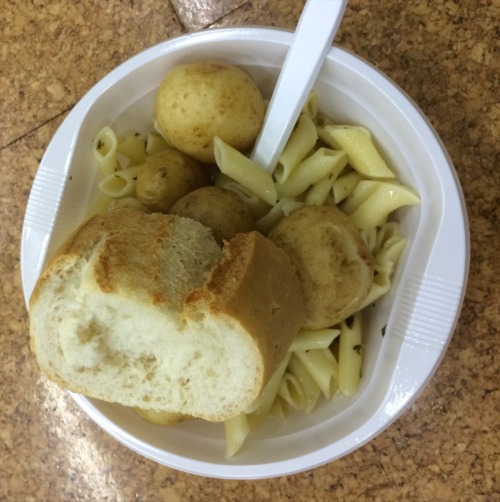
The hut felt a little like a war zone. There were beaten up bodies everywhere. Some runners were on mats in the corner stretching. A few nursed bloody wounds, others had their heads buried in their hands groaning. A few were packed up ready to get a lift back to Meloneras having volunteered their own DNF. Tempting! But the pasta was an instant hit and I shook myself out of this malaise. We had flown 1800 miles to be here not accounting for the road miles at both ends. Considerable time, effort and money had gone into my entry. My family were following me at home on the live tracker. They would have seen me go past Roque Nublo. I owed it to them to continue. Olive would be asking why had I not reached Pico Nieves yet. After all it was only 5km.
I stood up with determination, hurriedly doused myself in suncream and smothered block on my nose and lips; discarded my wind jacket in the drop bag and grabbed some spare electrolytes; handed in my drop bag; topped up my bottles and bladder. Reinvigorated I departed Garañón ready to tackle whatever the island dished out.
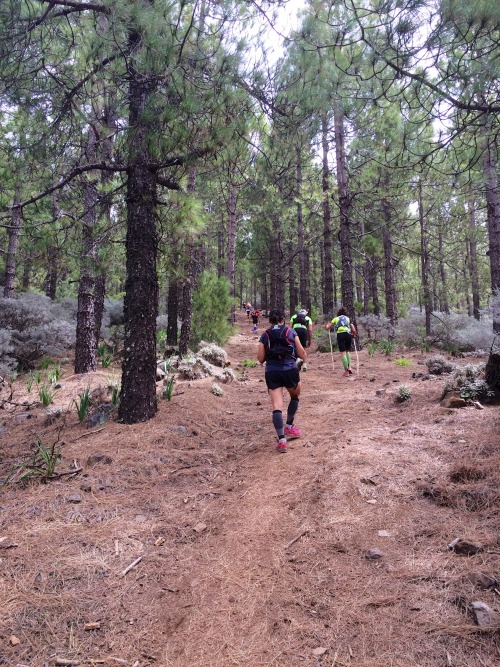
First up, the steep climb to Pico de las Nieves, the highest point on the island at 1949m. Once again the path was lined with pine trees the track littered with woodland debris which at times made grounding quite challenging in my deep lugged Roclites. Having spent twenty minutes at the feed station I found myself surrounded by new faces and everyone was taking the ascent very slowly. My legs appeared grateful for the rest and took to the challenge with some aplomb. We climbed 250 metres in just over a kilometre. Finally 6 hours 52 minutes since leaving Fontanales I stood in the shadow of a giant golf ball at the top of Gran Canaria. This time there was no handheld scanner, we just ran through a gate that registered the chip embedded in our numbers.
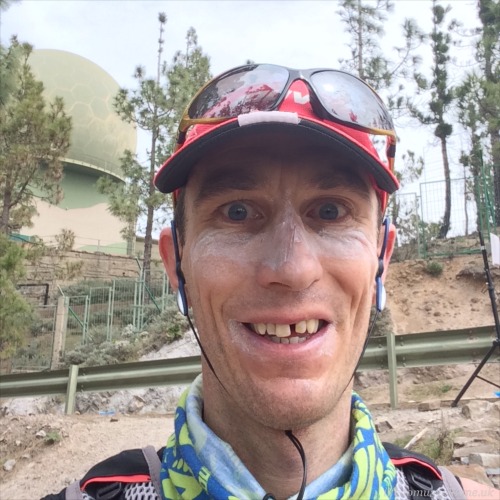
Relief flowed through me. I had reached the highest point of Gran Canaria. Now a chance to test my mettle against the technical descents.
Downhill all the way!
Pico Nieves to Tunte (251m ascent)
Before starting the descent I felt the urge to go to the toilet for the first time all day. A chance to assess my hydration behind a pine tree. Dark but not deadly! Assurance that I was sipping enough water. Then, I decided to check the live tracker on my phone. I was 170th overall and 47th (out of 132) in the M40 category. Being the only British representative in this category I felt it was my duty to improve over the back half of the course. I also knew the kids would be checking the tracker at home and I had slid quite a few places since Teror due in part to my slow climbing and the twenty minute rest at Garañón. So jumping a few places might raise some excitement on the sofa.
Initially the descent was rocky, steep and technical before levelling out in further pine forest with plenty more roots obstacles. From Llanos de la Pez we joined Camino de la Plata, a well walked route used by pilgrims to traverse the island. I had watched YouTube footage of the cobbled trail winding through the cliff side and looked forward to the experience. For now, concentration was called for on the uneven terrain as I watched every footstep and maintained a good pace, picking off runners one by one. There was enough breeze to keep the heat at bay.
Then we left the woodlands behind and a surreal lunar landscape, devoid of any vegetation, revealed itself.
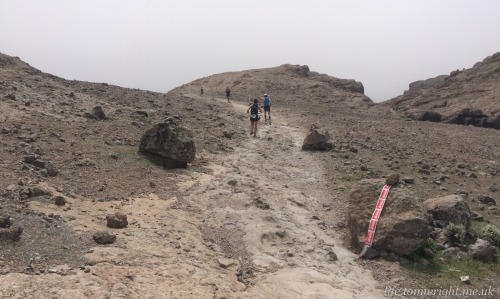
I couldn’t resist stopping to take a photo and a few more on the cobbled switchbacks. Despite the calima dust, the landscape was imposing and it was incomprehensible the challenge involved to build this path up such steep cliff faces. The cobbled stones appeared to be resting atop each other which allowed plenty of opportunity to catch toes and further batter the feet. The sharp switchbacks were also steep and punishing on my quads.
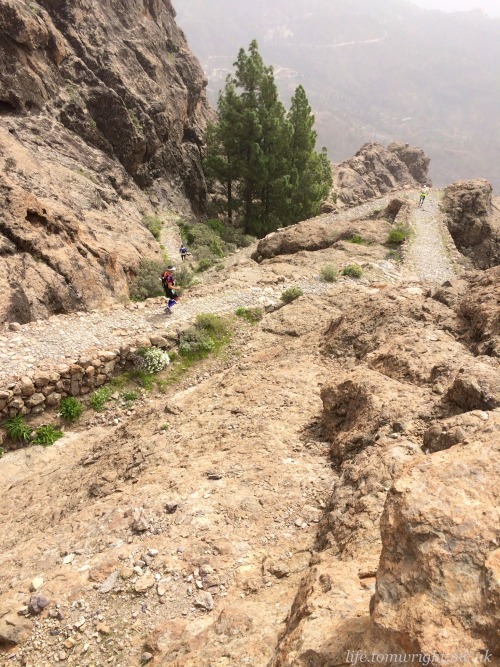
The cobbled pathways of steep switchbacks intersect the near vertical cliff as a well trodden access route between the fertile north and the arid south of the island.
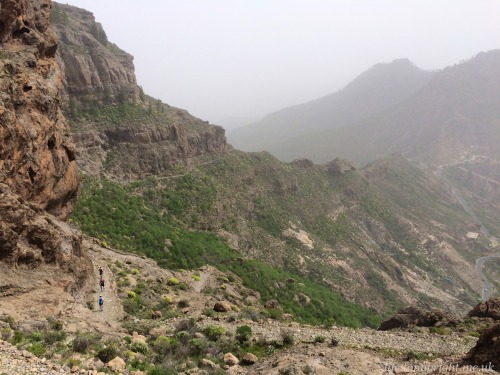
Camino de la Plata follows the ridge line south to Cruz Grande.
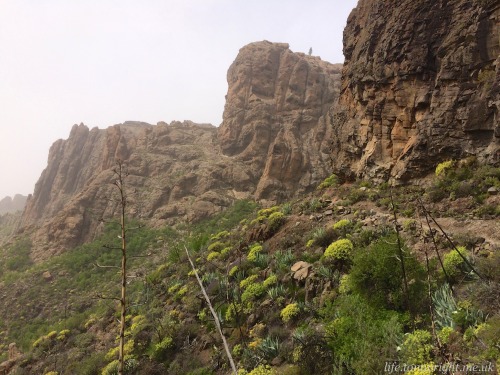
Looking back at the cobbled switchback that veers up the side of the mountain
The visual spectacle was enough to overcome the pain I was feeling in my quads after four miles of descent on rock hard terrain. The flora was quite different to the northern pine forests with all kinds of unusual succulents and flowers. Maybe it was the light reflecting but one plant actually appeared covered in silver spray paint. Deceived by my heat addled brain?
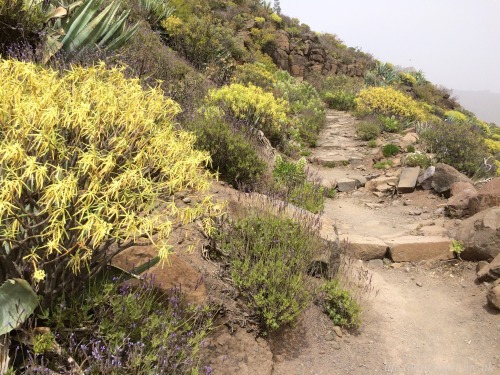
Much of the flora of Gran Canaria is unique to the island
We cut south across a ridge to Cruz Grande and then a rubble track wound down to Tunte. I found I was catching my toes repeatedly and both big toenails felt bruised. The wind faded and temperature rose rapidly as we descended. Despite regular sips of liquid my mouth and throat felt parched from the dry, dusty air. How I longed for an ice-cold drink. Sucking my way through a pack of Clif shot blocks did little to energise me. Mentally I had enjoyed this section but physically I was feeling exhausted again and the legs and feet were aching. Perhaps a bit more climbing wouldn’t be a bad thing!
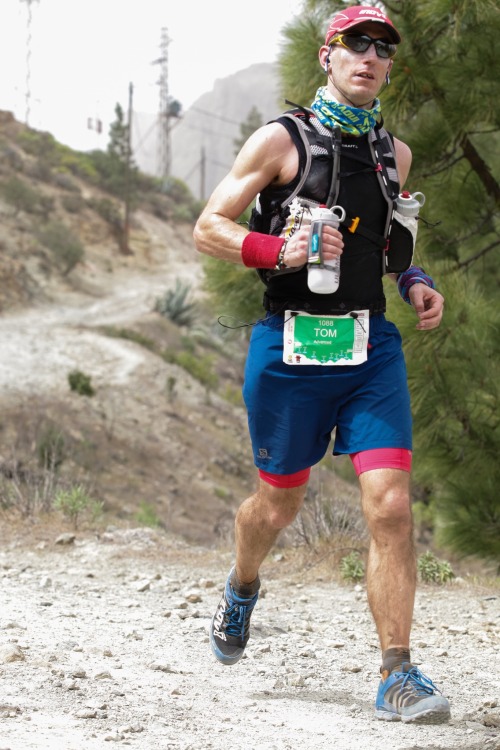
A tarmac road led us around the town’s periphery and another short quad burning descent finally bought us into the feed station.
I made a beeline for a bucket full of ice water and put my hat in it. Then I scoffed a handful of orange quarters, grabbed some ice cubes and placed them under my cap, filled my bottles and made a hasty exit before a spare chair enticed me.
Tunte to Arteara (706m ascent)
At fourteen kilometres this was the longest section of the course and it started with another long gradual ascent as we cut through the mountain side to the Degollada de la Manzanilla pass. A gradual incline took us under the impressive rock faces of Morro de las Vacas. I tried to jog a few sections but generally found myself power walking. Runners spread out quickly after Tunte and no-one was passing me now. For the first time I really felt like I was out here by myself.
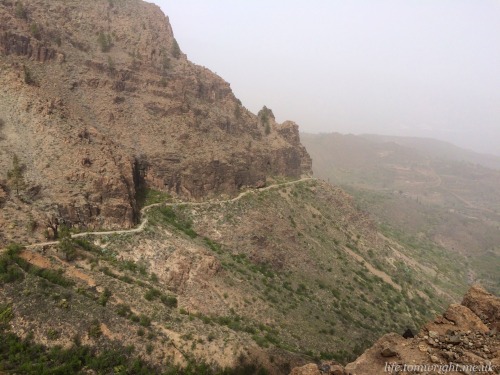

Another switchback leads to the Degollada de la Manzanilla pass
Nearing the end of the climb I saw a little card on the path saying “smile”. This was the cue for an official photographer. I did more than smile, I even put in a little jog - probably the last time I ran anything steeper than level for the rest of the race!
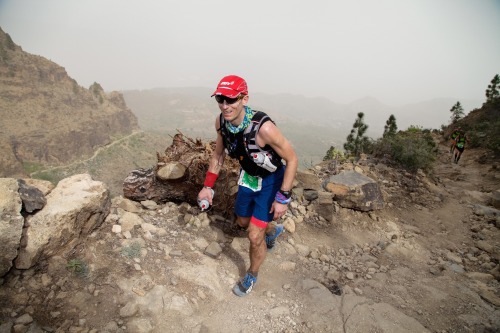
From the pass I had an opportunity to look down through the dust laden haze on the giant caldera which houses San Bartolomé (Tunte). Before joining a gravel road that ran for several miles in the eastern lee of the mountain. I have little recollection of this section of the course. It was dry, barren and very hot while the brume restricted panoramic visibility and dampened the visual experience. The vegetation was a lot less diverse than the fertile subtropical valleys north of the mountains. My legs were tired but so long as the track was level I continued to run, clinging on to two runners in sight about 200 metres ahead of me. When the track descended I found myself catching and then overtaking them despite my downhill speed being heavily restricted by aching quads and battered toes. Roclites weren’t such a good idea after all. Something with a little cushioning would have been most welcome on these gravel tracks.
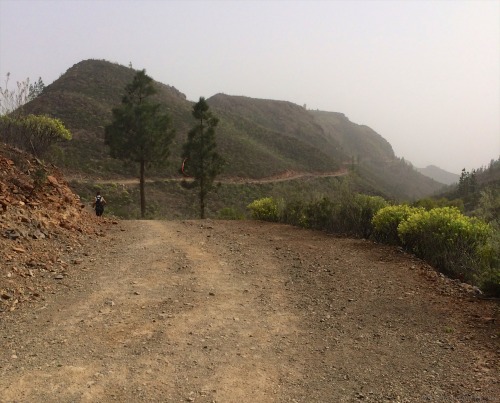
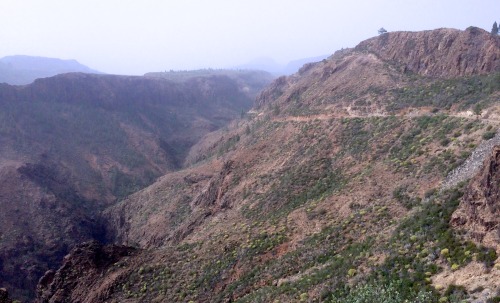
Then as my mind wandered my right foot caught another rock and I lunged. The cramp was agony, the toenail torture. But somehow I managed not to hit the deck. I was determined to get through this race without bloodshed.
I was longing to reach the heady drop-off to Arteara. This was the steepest section of the course and I had naively assumed an opportunity to make up some of the time lost climbing the central mountains.
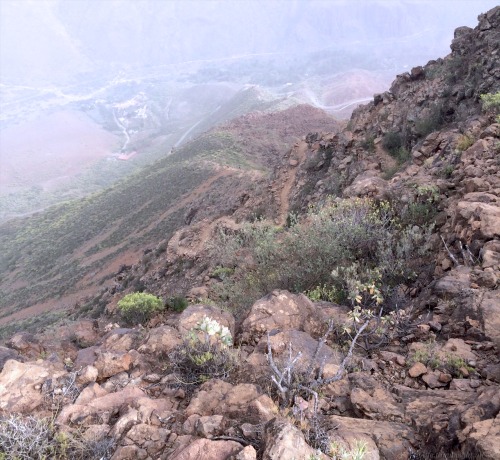
The descent looked treacherous, long and very steep. This was not the kind of terrain for making up time! The rocky path was similar to the Cornish coastal trails I train on and my experience appeared to help, as, despite a slow pace, I was picking off a lot of runners. Most were walking. I was hopping amongst the stones trying to pick out the safest path to land my feet ahead of me. A couple of times I almost overran the tight switchbacks and ground to a halt as loose rubble spilled over the steep precipice. It was pulsating and exciting. What a thrill this would be on fresh legs!
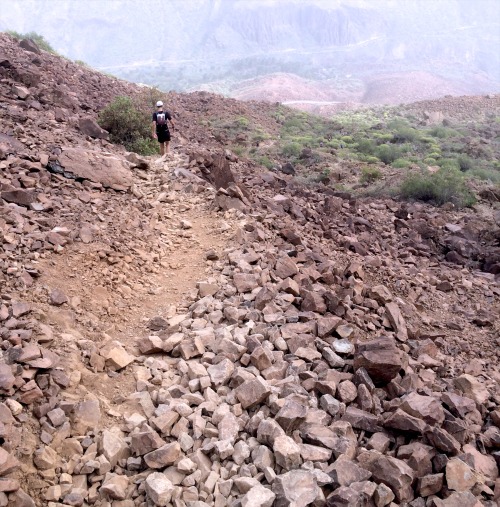
By the time I arrived at Arteara I was up to 125th place overall.
Arteara to Machacadora (358m ascent)
Once again I settled for a handful of orange slices and was immediately on my way. The day was fading fast with approximately 2 hours of daylight remaining and 19km to the finish.
As I followed the dry river bed of Barranco de Fataga through a line of tall palm trees, memories flooded back of the dry river mouth in Valencia. A sudden change in vegetation heralded our pending departure from the mountains as the course now gradually wound downhill to the urban sprawl of Maspalomes. Do not underestimate this last fifth of the course!
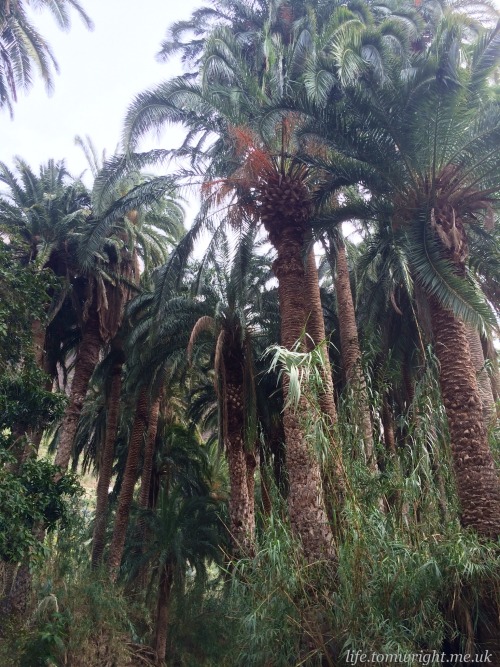
I think I mis-managed my nutrition throughout the day and all energy was spent. I walked and was content to continue to do so for the final few miles to the finish. It would seem an ultra cannot be run on oranges alone!
Then a text came through from Nadia.
5:16pm: ‘Ella has just shouted “come on dad” at the computer’
Instantly I welled up. It was Ella’s strength and resolve when she was incubated in Spain that first allowed me to conquer my irrational fears of mountain running. Then around my 40th birthday in November Ella had been frightfully sick and intubated for several weeks. This combination of events had bought me to where I was today. I challenge myself with these events to inspire my children and test my own strength and resolve. Ella is only just learning to talk and briefly visualising her, curly mat of hair, shouting at the computer bought tears of joy. I had purpose again and a race to finish.
A man of spiritual inclination may have looked deeper into what happened next.
There were near 3000 competitors taking part and before the race I had only met one of them before. That was Michael (Carraz) who I had briefly run alongside after the hot feed station on the Brecon 10 Peaks. He, and his wife Laureda, were far stronger than me that day and went on to top ten finishes. I knew, via social media, that he had returned to run the 125km course for the second consecutive year. What were the odds that as I looked to my left there he was walking along beside me! Perhaps, statistically, the fact we both had intent to run sub 12 and 20 hours, to earn our respective miniatures would suggest there was a chance we may encounter each other over those last slow miles.
The conversation helped another unexpected climb pass quickly. We had both resigned to the fact those miniatures were unattainable. Eleven miles of gradual downhill in 90 minutes would be tough on a good day. But with heavy legs, hungry and probably dehydrated a thirteen hour finish would be achievement enough.
On reflection only once had I run with another runner for any length of time and that was my inaugural ultra on the Gower in 2012. Mike dictated when we ran. Getting going was the hardest part for me on painful legs but once I had rhythm it got easier and I would dictate our pace. So we both bought unique prowess to this temporary alliance and through our collective experience the journey’s end came closer.
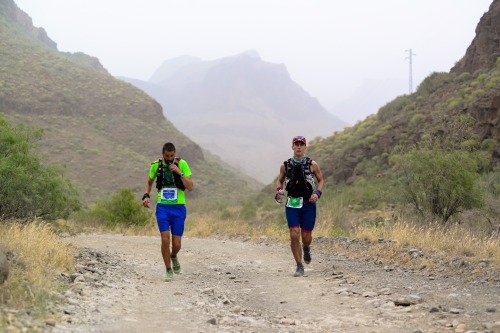
But how long did that final feed station at Machacadora take to arrive!
We passed one runner from the 125km lying on the side of the road. He said he was fine and just needed a little rest. Mike admitted that he would have gladly lain down alongside him. Mike also confessed he was having trouble with his kidneys and peeing blood. That did not sound good. What that guy, and all those runners had been through. My tribulations pail into insignificance in comparison! In honesty this dusty, rocky leg of the course provided little satisfaction. Lack of views as we just ran through the barranco with high cliffs on either side. I really just wanted to get out of the mountains now. I had had enough. My feet hurt, my legs hurt, my throat was dry from the calima. I was spent!
Machacadora to Maspalomas (52m ascent)
I walked in to Machacadora. Michael jogged in ahead to meet up with Laureda. The feed station, in the middle of nowhere, was a hive of activity with pumping music and a veritable feast of nibbles to fuel runners for the last few miles to the finish. I topped up my bottles scoffed more orange and was raring to go. Michael was comfortably sat in a chair and I said my farewells. What a surprise when he leapt up and declared he was with me. We headed off the access road onto a track as Laureda honked her car horn in support. I was feeling broken but the fact Michael had joined me I felt necessity to run. The underpass looked a kilometre distant and I promised myself that if I could just run to the bridge I would have a break. There was urgency to this plan as the sun had now drifted below the horizon and dusk was rapidly falling. Mike assured me once in the river bed we would have street lights to guide us the last few miles to the finish.
The underpass came and went. I tried to sustain momentum as we entered the river bed but I felt mentally weak and the urge to walk was overpowering. Michael was concerned about our pace and, determined to break 21 hours, ran on ahead. I promised I would catch him after a short break. So after sharing the last 100 minutes of the course I watched Michael gradually fade into the distant darkness of the never-ending river bed. As courses go this was certainly a tough twist to end the adventure. The dry bed ran for two kilometres over uneven paving stones. While the terrain was nothing compared to the rugged paths of the mountain, on tired legs it took great concentration. And quite frankly I had very little concentration left to give. I noticed a lot of broken bottles littered along the bed and this was enough incentive to rally one last time and stay on my feet.
Following Mike’s departure it took some time to gain composure. I consumed a caffeine gel and put some trance on my iPod. Light was fading fast and the distant street lights did little to illuminate the way. Gradually I picked up my pace. Relief came when I scrambled out of the bed and onto the promenade. Despite everything my body had endured I promised myself I would run the final two miles. More fool me as the organiser’s had one final surprise. An apparently unnecessary detour across 200 metres of beach! As I ran into the soft sand I sensed surprise from a few spectators on the promenade. This added to my determination to keep running and the pace might have been slow but I dragged my legs across that soft beach and back onto the final stretch of promenade. Passing the lighthouse I banked right along the shop fronts overtaking another couple of runners. Pace was improving as I sensed the finish approaching and a last pulse of adrenaline fuelled energy flowed through me. Then I was marshalled across 200m of gravel track with no street lights. I couldn’t see a thing but it was too late to start rummaging around for my head torch. Why I didn’t just dig out my phone I don’t know. I lifted my legs high in the hope I didn’t catch an unsuspecting rock and break blood so late in the day.
The music was pumping as I rounded the final bend. The atmosphere was like nothing I have experienced. It was inspiring. Crowds of spectators still cheering runners in and I put on a little burst of speed to the finish line passing a few more runners as I went. Somewhere in that throng was Nadia. For the first time she would see me finish a race. Again tears welled up. I wondered if the kids were still awake at home watching the live stream of the finish.
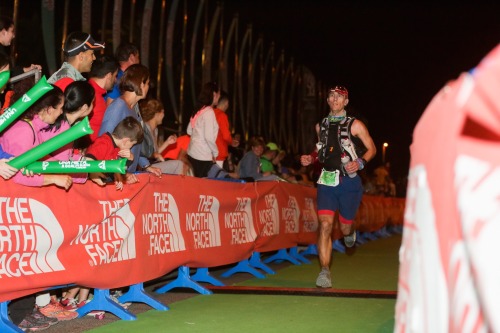
Then, in the space of a few seconds. It was all over!
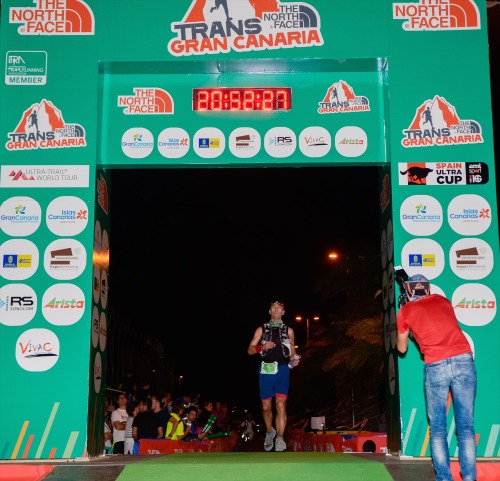
I finished Transgrancanaria Advanced course in an official time of 12:50:49. I was 129th overall and 36th in my class (M40).
The Aftermath
It has been nearly three weeks since we flew out to Gran Canaria and as is so often the case the adventure feels like a distant dream. This report has allowed me opportunity to cling on to that dream. When I started running coastal trails, and then marathons and finally stepping up to ultras in the UK, I never imagined I would one day run an event on the scale of Transgrancanaria.
Would I go back? Michael said: “It will be easier to think about doing again in a couple of months when we have forgotten the suffering :)”
After the race I found Michael slumped on a step. He may have been beaten inside but on the surface he carried a huge smile and looked like he could do it all again!
The race was excellent value for money. We got a wealth of goodies - teeshirt, buff, visor, finishers gilet, medal - and a good selection of photos at a reasonable price (compared to some of the UK events). The support on the course was exceptional. I really felt I was part of something, rather than just out for a very long run.
The course was as challenging as expected. The climbs long and steep and the descents really technical. The last 10 miles were not fun! For a race they bought an additional challenge since the terrain really allowed fast running if the legs were capable. For a plodder they just bought more pain!
The legs are still suffering but maybe one day when the pain has gone I will start contemplating another attempt at earning one of those sub 12 hour miniatures. Or maybe even tackling the monstrous 125km course!
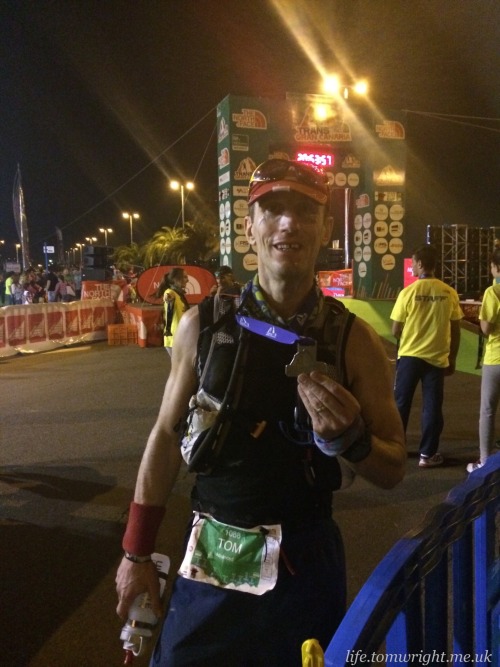
Another hard-earned medal for the collection
